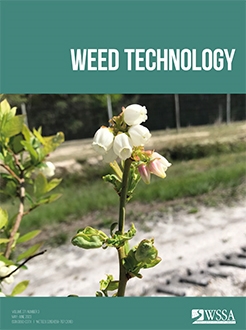Northern highbush blueberry is an important fresh market product in New Jersey where the plant was first domesticated in the early 20th century. Because of the short period for safely and timely applying postemergence (POST) herbicides, reliance on residual herbicides that provide season-long control of weeds is essential for blueberry growers to minimize the detrimental effect of weed competition on berry yield and quality and bush growth. Field studies were conducted from 2018 to 2020 in Chatsworth, New Jersey, on ‘Bluecrop’, ‘Duke’, and ‘Elliott’ blueberry cultivars growing on sandy acidic soil to evaluate weed control and crop tolerance in response to repeated annual applications of indaziflam at 73 or 146 g ai ha–1 applied in fall or spring. The efficacy of indaziflam treatments were compared to those of fall-applied dichlobenil at 3,300 g ai ha–1 or a spring-applied mix of diuron at 1,800 g ai ha–1, oryzalin at 3,360 g ai ha–1, and mesotrione at 210 g ai ha–1. Indaziflam at the currently labeled rate of 73 g ai ha–1 provided ≥85% and season-long control of horseweed, Canadian toadflax, and large crabgrass with fall applications on dormant blueberry, whereas spring applications were less effective. Whereas minor (≤8%) and transient leaf crinkling was noted in response to spring-applied indaziflam at 146 g ai ha–1, a fall application never caused leaf crinkling greater than that observed in the nontreated weedy and weed-free controls, regardless of rate. No negative effects on plant growth or fruit production were observed from indaziflam applied at 73 or 146 g ai ha–1 in fall or spring. Findings of this study suggest that indaziflam applied at 73 (1× commercial use rate) and 146 g ai ha–1 is safe to use on blueberry grown on New Jersey sandy acidic soils despite restrictions for using this herbicide on such soils.
Nomenclature: Dichlobenil; diuron; indaziflam; mesotrione; oryzalin; American burnweed Erechtites hieraciifolius (L.) Raf. ex DC.; carpetweed, Mollugo verticillata (L.); horseweed, Conyza canadensis (L.) Cronquist; large crabgrass, Digitaria sanguinalis (L.) Scop.; narrowleaf goldentop, Euthamia caroliniana (L.) Green ex Porter & Britton; Canada toadflax, Nuttallanthus canadensis (L.) D.A. Sutton; Pine Barren flatsedge, Cyperus retrorsus Chapm; northern highbush blueberry, Vaccinium corymbosum L.






